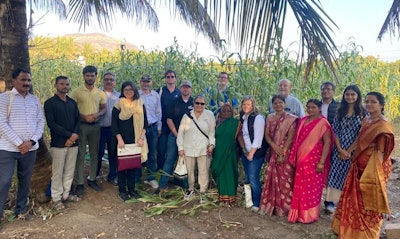
The U.S. Grains Council (USGC) has embarked on an exploratory mission to India, highlighting the potential of U.S. sorghum in addressing India's looming coarse grain shortage. This shortage, caused by a growing population, reduced monsoon rainfall and increased corn consumption, has prompted the need for alternative grain sources. The mission, conducted in partnership with the United Sorghum Checkoff Program (USCP) and the National Sorghum Producers (NSP), spanned six cities over five days, focusing on the versatile applications of U.S. sorghum.
Jace Hefner, USGC manager of global trade, emphasized India's historical use of sorghum, particularly in its snack food market. The delegation's full analysis of the Indian sorghum market included visits to jowar (Indian sorghum) farms and discussions on incorporating sorghum into high-end food products.
U.S. sorghum's tannin-free nature, a contrast to the high tannin content of Indian jowar, drew interest from the Indian feed manufacturing industry. This characteristic positions U.S. sorghum as a promising feedstock for India's expanding animal feed industry.
Furthermore, the delegation toured a starch processing plant, presenting research funded by USCP that showcased sorghum's superior starch yields compared to Indian corn. This aligns with India's growing demand for raw materials in starch manufacturing.
The mission concluded with a focus on U.S. sorghum's suitability for ethanol production, supporting India's E20 blend policy aimed for 2025/2026. "Sorghum's low-carbon production, minimal water and fertilizer requirements make it an ideal choice for sustainable ethanol production in India," Hefner stated.
Norma Ritz Johnson, USCP executive director, hailed the mission as a successful first step in securing U.S. sorghum opportunities in the Indian market.
In a parallel development, the Council's Latin American and Mexico offices hosted a regional buyers' conference in Cancun, Mexico. Attended by over 90 buyers, the conference facilitated an exchange of experiences and knowledge about current market conditions, including U.S. corn quality and logistics. Marri Tejada, USGC Latin America regional director, emphasized the importance of staying at the forefront of industry developments.
Lastly, the joint officers' mission led by USGC and the National Corn Growers Association (NCGA) to Japan highlighted the longstanding trade relations between the U.S. and Japan. Brent Boydston, USGC chairman, noted the mission's role in showcasing the Council's global market success and involving partners in these efforts. Japan remains a significant market for U.S. grain exports, with strong demand for U.S. corn, beef, and pork products.
These initiatives by USGC and its partners underscore a strategic approach to expanding global markets for U.S. grains, fostering sustainable agricultural practices, and strengthening international trade relations.
















